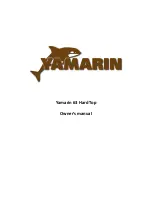Reviews:
No comments
Related manuals for 37 ST

YACHTLINE 360
Brand: Zodiac Pages: 31

Craz
Brand: Moomba Pages: 72

224 Sunesta Wide Xtreme
Brand: Chaparral Pages: 51

Sport 240
Brand: Mercury Pages: 42

360 Degrees Angler
Brand: Blue Sky Boatworks Pages: 21

Hewes Redfisher 16
Brand: Maverick Boat Pages: 23

F380
Brand: SEALINE Pages: 95

ABJET 285
Brand: AB Inflatables Pages: 47

jet boat
Brand: Scarab Pages: 156

PRO 750
Brand: Zodiac Pages: 210

VX110Sport
Brand: Yamaha Pages: 133

XLT1200 WaveRunner 2003
Brand: Yamaha Pages: 60

42 Fly-Grande Coupe
Brand: Regal Pages: 386

DOWNEAST 36
Brand: Lowell Pages: 2

63 Hard Top
Brand: YAMARIN Pages: 47

67 Day Cruiser
Brand: YAMARIN Pages: 104

FastCat12
Brand: Sea Eagle Boats Pages: 16

PaddleSki 395ps
Brand: Sea Eagle Pages: 9

















